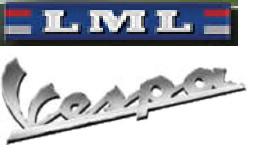Italy’s scooter classic can cut the mustard almost 60 years on, say Janie Omorogbe and Nicholas Rufford
How does Jamie Oliver carry his groceries from the supermarket? By Vespa of course. How did Gregory Peck woo Audrey Hepburn in Roman Holiday? By taking her on a romantic ride through the streets of Rome on a Vespa.
If things are useful they last and if they last long enough they become icons. In 1946 the first Vespa — the word means wasp in Italian — married practicality with styling. It was soon as synonymous with scooters as Hoover and Biro are with vacuum cleaners and ballpoint pens.
Originally intended for the masses in post-war Italy, it was the answer to a crippled economy. Affordable and robust, it meant men and women could get to work despite the state of the bombed roads.
Corradino D’Ascanio, an aeronautical engineer, designed it with the non-motorcycling customer in mind. He intended to offer a sleek means of transport with some of the practicalities of a car and the fun of a motorcycle. He produced a winning design, including the “step through” configuration of seat and frame that lets a woman in a dress ride one.
Old Vespas had the rear brake pedal in the footwell and you changed gear by pulling in the clutch and twisting the left-hand grip in steps. These days things are even simpler, hence the phrase “twist and go”. By the mid-1950s Vespas were being made not just in Italy, but in Britain, Belgium, Spain, France and Germany, with India and Indonesia following soon afterwards.
They have subtly evolved with each decade in both design and image. After Roman Holiday in 1953, sales soared for Piaggio, the Italian manufacturer. They were further boosted by films such as Quadrophenia that helped ingrain an image of a young carefree lifestyle.
If you’ve driven in Italy you’ll know they’re everywhere. They pop like champagne corks out of side turnings and bounce over the potholed roads. In cafes there are pictures of 1960s starlets astride leather saddles wearing hot pants. Now the chic state of undress is diluted by laws requiring crash helmets, but Vespas remain the coolest thing to be seen on.
It’s been almost 60 years since the first Vespa. The styling has matured with age while remaining true to its roots and popularity has continued to increase. Evidence of that can be seen in motorcycle parking bays across London. Commuting doesn’t have to be a frazzled combination of the Tube, buses or jostling through crowds. Just jump on your Vespa, pop a lid on and you’re off.
At first glance the new Vespa LX looks like a hybrid of the Vespa Granturismo (GT) which was launched late in 2003, and the more compact ET series that this scooter will replace. From the front it’s as curvaceous as the GT but smaller. The styled fairing protects against the weather. There’s ample legroom and a small glove compartment. The seat is comfortable, too. It’s big enough for passengers and it has a “curry hook” that slides out from the seat unit, giving you somewhere to hang your handbag — or bag of curry.
The seat unit houses enough space for a helmet to be locked away. Vespa wheels have traditionally been solid, making it impossible to lock them with a chain to a lamppost. The LX, however, has 11in spoked wheels that are smart and practical.
The bike’s slender proportions will be a godsend for women, although it can take loads disproportionate to its size — there are plenty of Vespas in Asia that carry families and animals. The steel body is tough and surprisingly light, making it easy to manoeuvre.
For commuters, two wheels seem an obvious solution. Big bikes are a blast on the open road, but this 4.3bhp two-stroke scooter is decidedly more suitable for stop-start London traffic.
It’s slim enough for filtering and nimble enough to nip between taxis and buses. The brakes are more than adequate. The only drawback is that the restricted engine tops out at a law-abiding 30mph, which can be slightly unnerving as soon as the traffic begins to flow.
Adopting a defensive stance in the middle of the lane causes a 30mph blockage, yet moving to the nearside to allow traffic to pass encourages car drivers to overtake far too close. A bit more power would have meant the bike could zip away from unexpected hazards.
That said, it is still a handy runabout that oozes Italian style by the bucketload. It comes in six colours (dragon red, black, grey, white, blue and plum) and there’s a choice of four engines from the nimble 50cc two-stroke that we rode to 50, 125 and 150cc four strokes, all of which are Euro 2 compatible.
So whether you’re looking for your first set of wheels, something to commute on or simply a fashion accessory, the LX may do the trick.
Vital statistics
Model Vespa LX
Engine type 50cc two-stroke
Power 4.3bhp
Fuel 110mpg
Performance 0-30mph: 5.9sec
Top speed 30mph
Price £1,799
Verdict Good fun and a great fashion accessory, but the 125cc version would be better
Engine type 50cc two-stroke
Power 4.3bhp
Fuel 110mpg
Performance 0-30mph: 5.9sec
Top speed 30mph
Price £1,799
Verdict Good fun and a great fashion accessory, but the 125cc version would be better

No comments:
Post a Comment